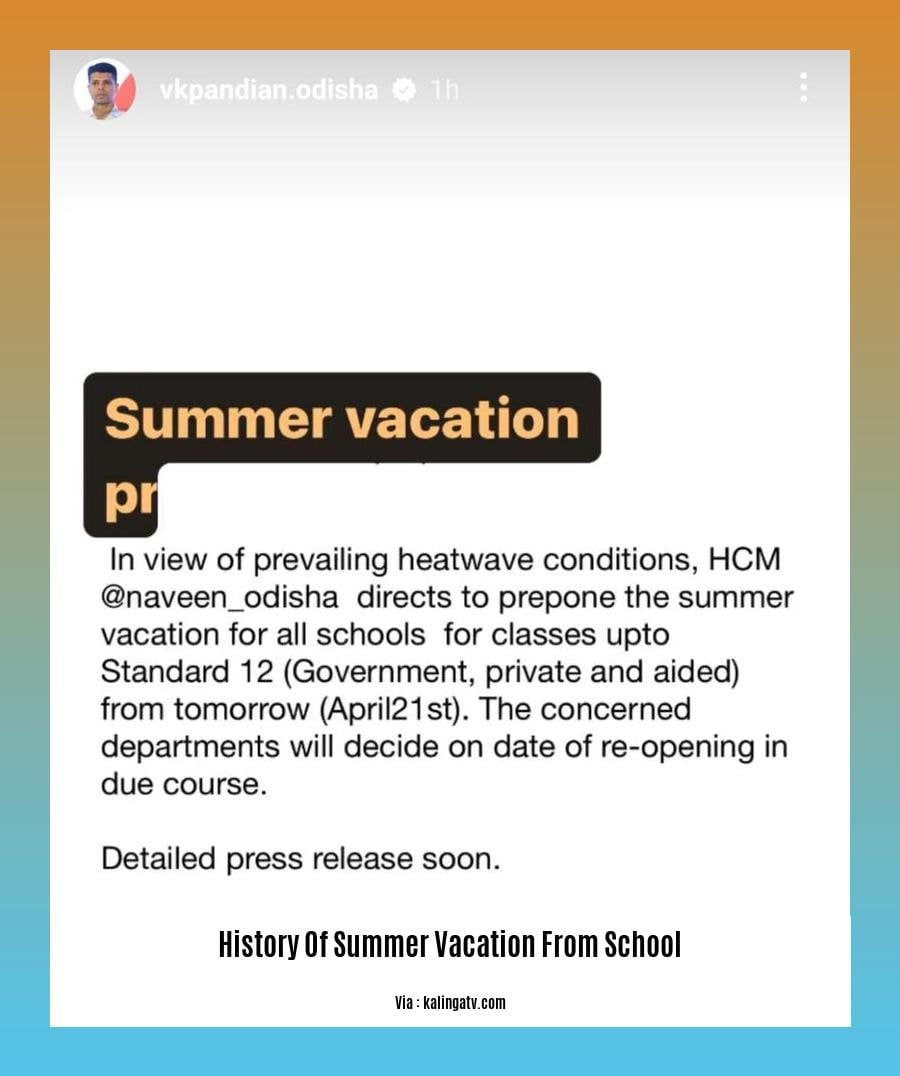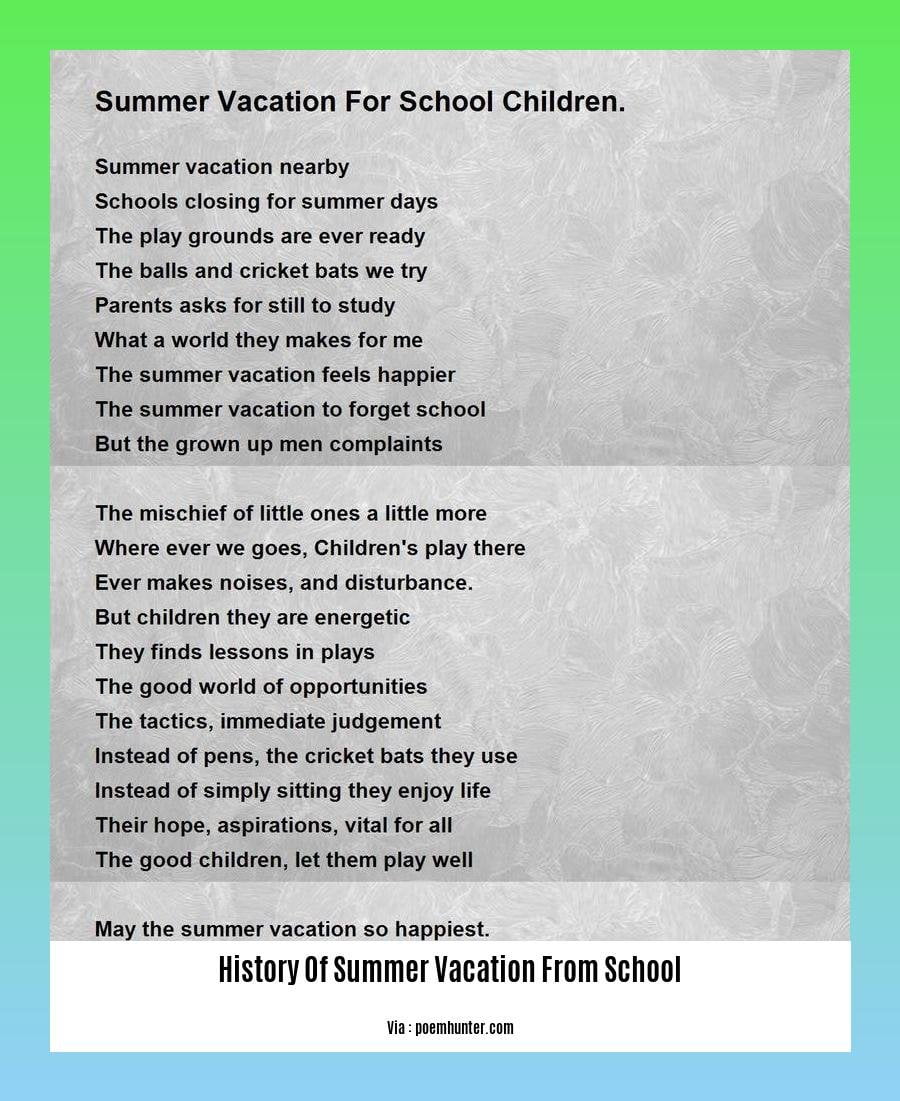[Unveiling the History of Summer Vacation from School]: Dive into the fascinating realm of summer vacations, a time-honored tradition that has shaped the educational landscape for centuries. This article unravels the rich tapestry of its origins, evolution, and cultural significance, promising a journey through archival records, scholarly texts, and firsthand accounts that illuminate the genesis of this cherished practice.
Key Takeaways:
- In the 19th century, large cities had long school years, with some reaching over 260 days.
- Summer vacations have been around for centuries, with the first recorded instance from the early 1800s.
- Some people believe that long summer vacations can hinder students’ progress and waste money.
- Many schools have moved to a calendar with multiple shorter terms and vacations to address the potential drawbacks of long summer breaks.
History Of Summer Vacation From School

Summer vacation, a beloved tradition in the educational landscape, has a rich and intriguing history. It’s a time for students to recharge, explore interests, and make memories. But when and how did this cherished break come to be?
The Seeds of Summer Vacation
In the early 19th century, American schools were structured differently than today. Students often attended school year-round, with only occasional breaks for holidays and special events. The academic year was typically longer, with 240 to 260 days of instruction.
The Growing Need for Respite
As the Industrial Revolution transformed society, the need for a more structured and efficient school system became apparent. Cities grew rapidly, and schools struggled to keep pace with the influx of students. Overcrowding and poor sanitation led to concerns about the health and well-being of both students and teachers.
The Role of Horace Mann
Horace Mann, a renowned educator and advocate for public education, played a pivotal role in the establishment of summer vacation. He recognized the importance of providing students with a break from the rigors of school and the opportunity to engage in recreational activities.
The First Summer Vacation
In 1841, Boston became the first city to implement a formal summer vacation, lasting from mid-June to mid-September. This break provided students with much-needed respite from the heat, noise, and unsanitary conditions of urban schools.
The Spread of Summer Vacation
The idea of summer vacation quickly gained traction across the country. By the early 20th century, most schools in the United States had adopted this tradition. The length of the break varied from two to three months, depending on the location and climate.
Summer Vacation Today
Today, summer vacation remains an integral part of the American educational system. It provides students with ample time to relax, explore their interests, and spend time with family and friends. Some research even suggests that summer vacation can help improve academic performance by reducing burnout and promoting cognitive development.
However, the History Of Summer Vacation From School is not without controversy. Some argue that the long break disrupts the continuity of learning, leading to “summer slide” in academic skills. Others contend that summer vacation provides essential opportunities for children to develop social, emotional, and physical skills.
Regardless of the debates, summer vacation continues to hold a special place in the American educational landscape. It’s a time-honored tradition that has evolved over centuries to meet the changing needs of students and society.
Explore the intriguing History Of Vacations and discover how this concept has evolved over time. Delve into the History Of Vacation Bible School to uncover its origins and impact on religious education. Learn about the emergence of History Of Vacation Rentals and their role in the tourism industry. Trace the development of History Of Vacations In The United States and its significance in American leisure. Discover the fascinating History Of Summer Vacation and how it became an ingrained part of the educational system. Dive into the History Of Disney Vacation Club and its influence on family-oriented tourism. Unravel the History Of Paid Vacation and its impact on the workforce and employee well-being. Investigate the History Of Bluegreen Vacations and its contributions to the timeshare industry. Explore the History Of Beach Vacations and their allure for relaxation and rejuvenation. Gain insights into the History Of Summer Vacations In America and its cultural significance. Finally, delve into the History Of Word Vacation to trace its etymological roots and linguistic evolution.
Evolution of Vacation Length and Purpose

Summer vacations are a beloved tradition, but have you ever wondered about their history? From their humble beginnings to their modern-day evolution, let’s explore the fascinating journey of school breaks.
Early Roots and the Rise of Summer Vacations
In the early 19th century, schools operated year-round, with only sporadic breaks. However, the Industrial Revolution brought overcrowding and concerns for student health. Inspired by Horace Mann’s advocacy, Boston implemented the first formal summer vacation in 1841, which quickly spread across the nation.
The Evolution of Vacation Length and Purpose**
Over time, the length and purpose of summer vacations have evolved. Initially intended as a respite for students, they now serve multiple functions:
- Rest and Recharge: Vacations provide students with time to disconnect, recharge, and engage in non-academic activities.
- Social Development: Extended breaks offer opportunities for social interaction, skill development, and community involvement.
- Enriching Experiences: Vacations allow students to pursue interests, travel, and explore new experiences that contribute to their holistic growth.
A Fine Balance: Summer Slide vs. Benefits
The length of summer vacations has been a subject of ongoing debate. Supporters of shorter breaks argue that they can mitigate “summer slide,” a phenomenon where students lose academic skills during extended breaks. However, proponents of longer vacations emphasize their importance for student well-being, social development, and extracurricular activities.
Key Takeaways:
- Summer vacations have evolved from their early roots as health breaks to their modern-day multi-faceted roles.
- The length and purpose of vacations have shifted over time, reflecting societal changes and educational priorities.
- The debate over vacation length highlights the need to balance academic rigor with student well-being.
Relevant URL Sources:
- History of Summer Vacation
- A Brief History Of: Summer Vacation
Social Impact of Summer Vacations
Summer vacations are a cherished tradition in the American educational system. But what are the social impacts of these extended breaks? Here’s a dive into the fascinating history and impact of summer vacations:
Origins and Evolution
Summer vacations originated in the agricultural era to free up children to help their families on farms. As urbanization and industrialization took hold, concerns for student health and well-being led to the advocacy of educators like Horace Mann, who stressed the importance of rest and recreation. In 1841, Boston implemented the first formal summer vacation, and the concept quickly spread across the country.
Disproportionate Impacts
Research indicates that students from low socioeconomic backgrounds and at-risk students are disproportionately affected by summer learning loss, also known as “summer fade.” These students may lack access to enriching activities and academic support during the break, widening the achievement gap.
Access and Socioeconomic Factors
Access to summer vacation can be influenced by socioeconomic status. Families with limited resources may not afford summer camps, travel, or other activities that enrich children’s learning and social development.
Controversies and Alternatives
The extended duration of summer breaks has raised concerns about the “summer slide” – the loss of academic progress made during the school year. In response, educators and policymakers have explored summer school programs, but their effectiveness remains a subject of debate.
Key Takeaways:
- Summer vacations were initially designed to support agricultural needs.
- Students from disadvantaged backgrounds experience greater summer learning loss.
- Socioeconomic factors influence access to summer vacation benefits.
- Extended summer breaks raise concerns about academic regression.
- Summer school programs offer a potential solution to summer learning loss.
Citations:
- History of School and Summer Vacation
- Why Do We Have Summer Vacation? Unveiling the Surprising History
Current Trends and Future of Summer Breaks
Summer Vacation Evolution
Summer breaks have come a long way since their humble beginnings as agricultural respites. Today, they’re an integral part of our educational system, offering students a chance to rest, recharge, and explore their interests.
Current Trends
- Year-Round Schooling: Some schools are experimenting with year-round schedules that include shorter, more frequent breaks.
- Extended Learning Opportunities: Summer camps, enrichment programs, and online learning are becoming more popular to help students avoid the “summer slide.”
- Technology Integration: Technology is playing a growing role in summer learning, with apps and virtual classrooms providing access to educational content.
Future Outlook
The future of summer breaks is uncertain. Some experts believe they will become shorter or eliminated entirely. Others argue that they’re essential for student well-being and should be preserved.
Key Takeaways:
- Summer breaks have a long history rooted in agricultural needs and student health concerns.
- Current trends include year-round schooling, extended learning opportunities, and technology integration.
- The future of summer breaks is uncertain, with some advocating for their elimination and others emphasizing their importance for student well-being.
Relevant URL Sources:
– The History of Summer Vacation
– Summer Vacation: A History
FAQ
Q1: Why was summer vacation implemented in the school system?
A1: Historically, summer vacation was established to align with agricultural needs, as children assisted their families on farms during the warm months.
Q2: What impact does summer vacation have on students from disadvantaged backgrounds?
A2: Research suggests that students from low socioeconomic backgrounds are more susceptible to academic regression during summer breaks, a phenomenon known as “summer fade.”
Q3: How has summer vacation evolved over time?
A3: Summer vacation became more prevalent in the late 19th century as a measure of school effectiveness based on the number of days it remained open.
Q4: What are the arguments for shortening or eliminating summer vacation?
A4: Supporters argue that it could help address the “summer slide” and provide more learning opportunities, while critics emphasize the importance of rest, social development, and extracurricular activities during the break.
Q5: What is the “summer slide” and how does it affect students?
A5: The “summer slide” refers to the academic regression that students experience during the extended summer break, potentially leading to a loss of progress gained during the school year.
- Unraveling Einstein’s Legacy: Who Inherited His Genius? - July 14, 2025
- Unlock Einstein’s Family Tree: Bernhard Caesar & Untold Stories - July 14, 2025
- Unveiling Bernhard Caesar Einstein: His Life & Albert Einstein’s Legacy - July 14, 2025
















